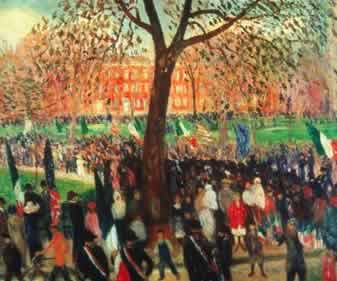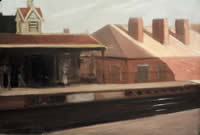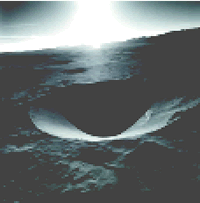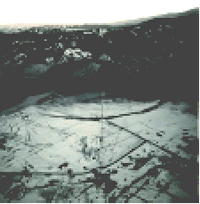
Edward Hopper (1882-1967)
Queensborough Bridge, 1913 Oil on Canvas
|
Edward
Hopper:
Capturing the American Scene
Edward Hopper is one of America’s most popular and
well-known realist painters, instantly recognizable for
his reductionist compositions and solitary figures.
Hopper sprang from the turn-of-thecentury period that saw
America undergo a profound transformation from an agrarian
to an urban society in the wake of the Industrial Revolution.
The result of this transformation was pictorialized by a
group of avant-garde painters who had come under the influence
of Robert Henri, the leading artistic figure of the early
20th century.
Head of the Pennsylvania Academy of Fine Arts, Henri was
a realist in the tradition of Thomas Eakins, whose controversial
renderings of anatomical dissections and nude figures had
rattled society’s 19th century Victorian sensibilities.
After traveling to France, Henri came under the influence
of
the French Impressionists, whose brash depiction of contemporary
life and “plein air” style offended traditionalist
academicians, yet ultimately led to the modernist movements
that flowered in the 20th century.
 |
William J. Glackens (1870-1938)
Parade, Washington Square, 1912 Oil on Canvas |
After returning to America, Henri advised his protégés—including
Hopper, George Bellows, George Luks, Everett Shinn, and
John Sloan—to take their inspiration from the streets.
Rejecting traditional pastoral landscapes for the grit and
grind of the city, the group became known as the “Ashcan
School.” The urban realists were initially reviled
but ultimately embraced as painters with the keenest eye
— the first truly American artists.
Hopper was the most atypical of the urban realists. He started
his career as an illustrator and printmaker, and his work
demonstrates his strong compositional style and emphasis
on form. His canvases gained attention when he began focusing
on American themes — cityscapes and urban interiors
presenting a new and poignantly melancholy view of urban
life that became known as “American scene” paintings.
Ever the individualist, Hopper worked in a flat, straightforward
style, attempting to capture an America tinged with melancholy
while living through the Great Depression.
According to Mary Francey BFA’71 MA’74 PhD’83,
professor of art history, the urban realists haven’t
always been given their due. “American modernism is
defined by the often paradoxical efforts to fuse art and
life, culture and experience in a society still struggling
with issues of national identity,” she says. “Hosting
an exhibition that encompasses the multiple styles of modernist
artists responding to the effects of migration, immigration,
urbanization, and communication is an important opportunity
for the UMFA to call attention to an under-recognized period
in the history of American art.”
 |
Edward Hopper (1882-1967)
The El Station, 1908
Oil on Canvas |
 |
Edward
Hopper (1882-1967)
Yonkers, 1916
Oil on Canvas |
“Edward
Hopper and Urban Realism”
May 16 to August 24
This exhibition was
organized by the Whitney Museum of American Art, New
York. It includes various artists working in New York
at the turn of the 20th century who were originally
associated with the influences of Robert Henri and
the Ashcan School—George Bellows, William Glackens,
Edward Hopper, George Luks, Everett Shinn, and John
Sloan. On display are samples of Hopper’s early
work against a general overview of the realist tradition
that culminated with the establishment of the American
Scene movement in the 1930s. The exhibition includes
approximately 50 paintings drawn from the Whitney’s
permanent collection.
|
 Emmet Gowin: Changing the Earth
Emmet Gowin: Changing the Earth
A half century later, photographer Emmet Gowin has also
brought a new and disquieting view of life on planet Earth,
albeit from the height of a satellite.
Currently a professor of photography in the Council of the
Humanities, Princeton University, Gowin has taught in the
Visual Arts Program since 1973.
Gowin is a “landscape” photographer, but not
in the traditional sense. He photographs military test sites,
missile silos, mining and off-road vehicle scarification,
gravel pits, pivot irrigation, and ammunition storage and
disposal facilities. The images he creates are abstractions
patched together from patterns etched on the Earth’s
surface —giant earthworks created by humans and their
technological tools.
A self-proclaimed environmentalist, Gowin refers to the
alterations of the Earth’s “face” as disfigurements
and brutalizations. In fact, his photographs can provoke
a conflicting response of appreciation for the beautiful,
ethereal images and revulsion for what they represent.
Gowin’s interest in nature came from a childhood spent
in rural Virginia, where he lived close to the land. After
making his way through the Richmond Institute and the Rhode
Island School of Design, he turned to photography, focusing
first on portraits of his wife, children, and extended family.
He became interested in aerial photography in 1996 when
Mount St. Helens erupted and he flew over the devastation
in an airplane. “Seeing that landscape for the first
time from the air was a revelation,” he says.
David M. Carroll, collections manager and chief registrar
at the UMFA, comments, “I find the images compelling
because, through a change in physical orientation, Gowin
has turned some of the most devastating examples of postindustrial
landscape into arresting compositions. Somehow seeing these
landscapes from above makes it possible to briefly forget
the human failings represented in their creation.”
 
“Emmet Gowin: Changing
the Earth, Aerial Photographs” -
April 18 to July 13
Emmet Gowin has been taking aerial
photographs of the landscape in the United States,
Mexico, Czechoslovakia, Asia, and the Middle East
for over 20 years. His most compelling photographs
illustrate how man’s footprint has visually
scarred and altered the earth’s surface. The
exhibit comprises 90 photographs, capturing scenes
ranging from ICBM missile sites to strip mines to
pivot irrigation farming. The exhibit will be accompanied
by a book, Emmet Gowin: Changing the Earth,
written by curator Jock Reynolds, with essays by
Philip Brookman and Terry Tempest Williams BS’79
MS’84, published by Yale University Press
(2002). This exhibition was organized by the Yale
University Art Gallery in association with the Corcoran
Gallery of Art.
|
—Linda Marion BFA’67 MFA’71 is managing
editor of Continuum. |
